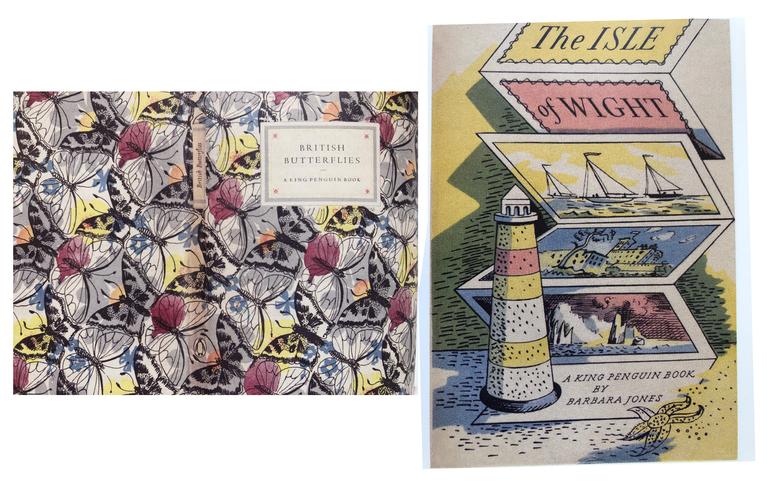Blog
20 May 2020

In the Graham Watson Collection, now in Emmanuel Library, is a complete set of the King Penguin series: some 76 slim hardback Penguins published between 1939 and 1959. Although hardly qualifying as ‘rare books,’ it is not surprising that Graham Watson, with his keen eye for book design and illustration, would collect this series. The King Penguins were shrewdly marketed as collectibles, aiming to appeal to what Penguin saw as the public’s ‘liking for illustrated keepsakes’. Soon overtaken by an era of total war, the King Penguins continued to appear nonetheless.
Contemporary Penguin publicity emphasized their role ‘at a time when so many of our galleries and museums are closed’ and presented the series as fulfilling ‘a useful purpose in promoting an appreciation of art and as a reminder of the pursuits of peace’. They were never exactly cheap: earliest editions cost one shilling (twice the price of a normal Penguin paperback or a packet of Woodbines), and by 1951 they cost five shillings, no trivial outlay for most people at the time. Their format was typically an essay-length text of 30 pages, followed by 16 plates, because subject-matter and illustration were interdependent, inviting the literary-minded to look and the visually-alert to read. The first editor, Elizabeth Senior, a Keeper at the British Museum, lost her life in the Blitz in 1941, to be succeeded by Nikolaus Pevsner, newly released from an internment camp, who then edited the series until its demise. Some of the texts were penned by Pevsner’s friends among the staff of the South Kensington museums. They did so out of a love for their subjects, since financial rewards for the authors were minimal.
The remarkable range of titles is a tribute to the public’s wartime craving for education and information as this lived on for a while into the immediate post-war period. The series provided a serious but not over-demanding text for the intellect and a small feast for the eye, all attractively packaged (but by the late 1950s no longer commercially viable). Typical print-runs were 20,000 copies, but A Book of Toys, with its appeal to readers of all ages, ran to 55,000. Penguin publicity in 1950 boasted of King Penguins on ‘anything from the Bayeux Tapestry to Balloons, from Heraldry to Highland Dress’ (and there are excellent King Penguins on those subjects), but amid the variousness there are some predominant themes. There is a strong emphasis on natural history and botany, including: A Book of Roses (1939), Edible Fungi (1944), A Book of Lilies (1944), Poisonous Fungi (1945), Flowers of Marsh and Stream (1946), Flowers of the Woods (1947), Tulipomania (1950), and A Book of Mosses (1950). Those observant gardeners and walkers in the British countryside who enjoyed such books might also like the noticeably large number of King Penguins about birds, including: British Birds on Lake, River and Stream (1939), Garden Birds (1945) and A Book of Ducks (1951). There were also Some British Moths (1944), British Butterflies (1951; with a ravishing cover), and Some British Beetles (1948), although A Book of Spiders (1947) sadly suffered the indignity of being remaindered.
Another various theme is British heritage and applied and popular arts, with King Penguins on English Ballet (1944), A History of English Clocks (1947), The English Tradition in Design (1947), The Crown Jewels (1951), and Animals in Staffordshire Pottery (1953). There is an enterprising Children as Artists (1944) and the excellent Popular Art in Britain (1945), with its focus on samplers and smocks, carts and caravans, fairground roundabouts and pub interiors. There was also The Picture of Cricket (1955) by John Arlott.
Pevsner’s own interests are reflected in King Penguins on medieval sculpture and artefacts such as Medieval Carvings in Exeter Cathedral (1953), Misericords (1954), Monumental Brasses (1957), all preceded by Pevsner’s own classic essay on the exquisite carved foliage in Southwell Minster, The Leaves of Southwell (1945).
A few topographical King Penguins – Romney Marsh (1950) ‘illustrated and described by’ John Piper, and The Isle of Wight (1950) by the illustrator Barbara Jones – are fascinating records of how things were visualized at the time. As these suggest, some of the leading illustrators and artists of the period were involved: Life in the English Village (1949) had sixteen lithographs by Edward Bawden. The book- and cover-designs of King Penguins rather contradict our lazy current orthodoxy – that this was a drab and colourless epoch – through the sheer stylishness and elegance of their design.
Barry Windeatt (Keeper of Rare Books)
Images by Helen Carron (College Librarian)
Back to All Blog Posts